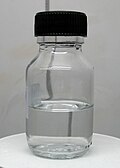Formic acid
|
|
|||
 |
|||
| Names | |||
|---|---|---|---|
|
Preferred IUPAC name
Formic acid
|
|||
|
Systematic IUPAC name
Methanoic acid
|
|||
| Other names
Aminic acid; Formylic acid; Hydrogen carboxylic acid; Hydroxymethanone; Hydroxy(oxo)methane; Metacarbonoic acid; Oxocarbinic acid; Oxomethanol
|
|||
| Identifiers | |||
|
64-18-6 |
|||
| 3D model (Jmol) | Interactive image | ||
| ChEBI |
CHEBI:30751 |
||
| ChEMBL |
ChEMBL116736 |
||
| ChemSpider |
278 |
||
| DrugBank |
DB01942 |
||
| ECHA InfoCard | 100.000.527 | ||
| EC Number | 200-579-1 | ||
| E number | E236 (preservatives) | ||
| KEGG |
C00058 |
||
| PubChem | 284 | ||
| RTECS number | LQ4900000 | ||
| UNII |
0YIW783RG1 |
||
|
|||
|
|||
| Properties | |||
| CH2O2 | |||
| Molar mass | 46.03 g·mol−1 | ||
| Appearance | Colorless fuming liquid | ||
| Odor | Pungent, penetrating | ||
| Density | 1.220 g/mL | ||
| Melting point | 8.4 °C (47.1 °F; 281.5 K) | ||
| Boiling point | 100.8 °C (213.4 °F; 373.9 K) | ||
| Miscible | |||
| Solubility | Miscible with ether, acetone, ethyl acetate, glycerol, methanol, ethanol Partially soluble in benzene, toluene, xylenes |
||
| log P | −0.54 | ||
| Vapor pressure | 35 mmHg (20 °C) | ||
| Acidity (pKa) | 3.77 | ||
| -19.90·10−6 cm3/mol | |||
|
Refractive index (nD)
|
1.3714 (20 °C) | ||
| Viscosity | 1.57 cP at 268 °C | ||
| Structure | |||
| 1.41 D (gas) | |||
| Thermochemistry | |||
|
Std molar
entropy (S |
131.8 J/mol K | ||
|
Std enthalpy of
formation (ΔfH |
−425.0 kJ/mol | ||
|
Std enthalpy of
combustion (ΔcH |
−254.6 kJ/mol | ||
| Pharmacology | |||
| QP53AG01 (WHO) | |||
| Hazards | |||
| Main hazards | Corrosive; irritant; sensitizer |
||
| Safety data sheet |
See: data page JT Baker |
||
| R-phrases | R10 R35 | ||
| S-phrases | (S1/2) S23 S26 S45 | ||
| NFPA 704 | |||
| Flash point | 69 °C (156 °F; 342 K) | ||
| 601 °C (1,114 °F; 874 K) | |||
| Explosive limits | 14–34% 18%–57% (90% solution) |
||
| Lethal dose or concentration (LD, LC): | |||
|
LD50 (median dose)
|
700 mg/kg (mouse, oral), 1100 mg/kg (rat, oral), 4000 mg/kg (dog, oral) | ||
|
LC50 (median concentration)
|
7853 ppm (rat, 15 min) 3246 ppm (mouse, 15 min) |
||
| US health exposure limits (NIOSH): | |||
|
PEL (Permissible)
|
TWA 5 ppm (9 mg/m3) | ||
|
REL (Recommended)
|
TWA 5 ppm (9 mg/m3) | ||
|
IDLH (Immediate danger)
|
30 ppm | ||
| Related compounds | |||
|
Related carboxylic acids
|
Acetic acid Propionic acid |
||
|
Related compounds
|
Formaldehyde Methanol |
||
| Supplementary data page | |||
|
Refractive index (n), Dielectric constant (εr), etc. |
|||
|
Thermodynamic
data |
Phase behaviour solid–liquid–gas |
||
| UV, IR, NMR, MS | |||
|
Except where otherwise noted, data are given for materials in their standard state (at 25 °C [77 °F], 100 kPa).
|
|||
|
|
|||
| Infobox references | |||
Formic acid, systemically named methanoic acid, is the simplest carboxylic acid. The chemical formula is HCOOH or HCO2H. It is an important intermediate in chemical synthesis and occurs naturally, most notably in some ants. The word "formic" comes from the Latin word for ant, formica, referring to its early isolation by the distillation of ant bodies. Esters, salts, and the anions derived from formic acid are called formates.
Formic acid is a colorless liquid having a highly pungent, penetrating odor at room temperature. It is miscible with water and most polar organic solvents, and is somewhat soluble in hydrocarbons. In hydrocarbons and in the vapor phase, it consists of hydrogen-bonded dimers rather than individual molecules. Owing to its tendency to hydrogen-bond, gaseous formic acid does not obey the ideal gas law. Solid formic acid (two polymorphs) consists of an effectively endless network of hydrogen-bonded formic acid molecules. This relatively complicated compound also forms a low-boiling azeotrope with water (22.4%) and liquid formic acid also tends to supercool.
In nature, it is found in certain ants and in the trichomes of stinging nettle (Urtica dioica). Formic acid is a naturally occurring component of the atmosphere due primarily to forest emissions.
...
Wikipedia



